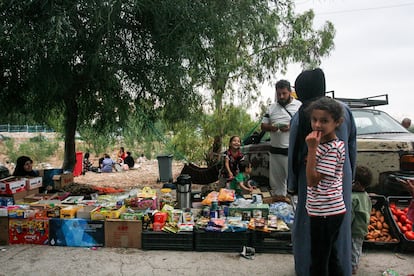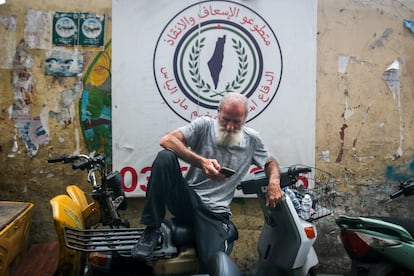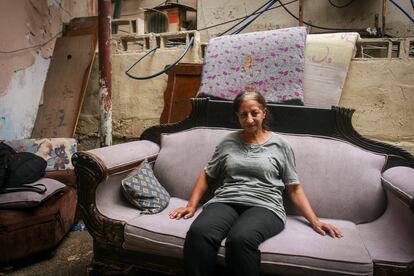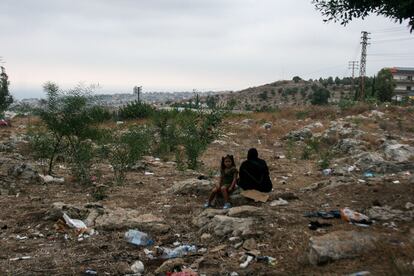From exodus to exodus: Palestinian refugees in Lebanon flee Israeli attacks
Israel has attacked or ordered the evacuation of half of the camps in the country, in a new forced displacement that connects with the images of Gaza


On October 5, a video on social media showed a crowd leaving Shatila, the Palestinian refugee camp in Beirut whose name has become intrinsically associated — along with the Sabra neighborhood — with the 1982 massacre perpetrated by the Lebanese Christian Phalanges. Israeli strikes had just hit targets near Shatila and hundreds of people were taking to their motorbikes and cars in search of a safer place, creating a traffic jam in the early morning. One of those people was Um Hasan, 61, and her immediate impulse was to get away from danger, but to stay with her family, so she speaks sitting on the edge of her bed in a dark apartment in Mar Elias, one of the six Palestinian refugee camps in Lebanon, out of a total of 12, safe until now from Israeli attacks and evacuation orders.
“This is far enough from Dahieh [the bombed-out Shia suburb of Beirut, a Hezbollah stronghold] and we are with our people. The way things are going, I don’t think we are close to being able to go home. It looks like it will be a long war. And if something happens here, we will go somewhere else. We are used to it. For my people, everything is displacement, there is never rest or stability. We have been tired ever since we were thrown out.”
If it were not for the significance of her family history, Hasan’s case would not be very different from the 20% of the population in Lebanon (more than one million inhabitants) who have been forced to flee their homes since last month due to the Israeli offensive, which has killed more than 2,000 people. But the “home” she refers to is the Palestine from which her grandparents previously fled. Specifically, the city of Safed, today part of Israel and from which the family of the president of the Palestinian National Authority, Mahmoud Abbas, also originates.

That was the during the Nakba (catastrophe, in Arabic), the flight or expulsion of 750,000 Palestinians (two-thirds of the Arab population in the current State of Israel) between 1947 and 1949, in the face of the advance of first the Jewish militias and, later, the newly created Israeli army. These 750,000 people ended up spread between Gaza, the West Bank, Jordan, Syria, and Lebanon; today, together with their descendants, they number about six million who have inherited the status of refugees.
The most logical escape route from Safed and other parts of the north at the time of the Nakba was the newly independent Lebanon, where there are now an estimated 203,000 Palestinian refugees: 180,000 who were already there and 23,000 whose families came from Palestine to Syria and who fled to Lebanon in 2011 when the civil war broke out in their host country. They live mainly in 12 refugee camps that have been emptied or filled in recent days, depending on their location, like connecting vessels. In Shatila, for example, which is barely a square kilometer in size, 20,000 people once lived. Today it is almost empty.
In recent weeks, Israel has bombed — sometimes to kill specific Palestinian militia leaders — or ordered the evacuation of half of the camps: in the north (Beddawi, in the city of Tripoli), in the center (Burj al-Barajneh, in Beirut) and in the south (Bass, Burj al-Shamali and Rashidia, around Tyre; and Ein el Hilwe, in Sidon).

As of October 14, the UN agency for Palestinian refugees (UNRWA) reported that 481 Palestinian refugee families in Lebanon, some 2,400 people, had contacted the agency while already in Syria. This is only a fraction of those fleeing, as not all of them register and remain off the radar.
One of the camps that has been emptying the most is Burj al-Barajneh, located very close to Dahieh and where Nayah al-Hussein, 60, arrived two weeks ago.
― Why did you choose Mar Elias?
― My two children did not want to go to school because they know that Israel is bombing Gaza and they are afraid. They have seen the images on their mobile phones and insisted on not going there.

Yaabad Sibhine held out longer in Burj al-Barajneh, until the day before, but “the bombs kept coming, the bakeries kept closing and it became increasingly difficult to get water and diesel for the electricity generators. Every day we saw more people leaving and I only felt calmer when I still had people around me,” he says. “And to think that at the beginning of the war, the inhabitants of the [Shia] villages came to the camp because it was safer…”
Fuad Baker, head of the legal department of the Democratic Front for the Liberation of Palestine in Mar Elias, describes the process: “At first it was a matter between Hezbollah and Israel, until Israel started attacking Palestinian leaders in the camps.” In Mar Elias, he estimates, there are about 1,500 additional people, including Palestinians and some Shias who have sought refuge.
Baker provides two reasons as to why they end up here, rather than in the schools that have been converted into shelters. One, family ties. These are important and extend beyond the immediate circle. The other, identity. “Historically, they prefer to be in Palestinian places, because Lebanese society is a bit racist towards us,” he says.
There are two factors that are not mentioned, because they are taken for granted. Firstly, that it is one of the camps with the least reputation for militant activity. Secondly, that the vast majority of Palestinian refugees cannot afford to do what some displaced Lebanese people who led comfortable lives can: live in hotels or rent an apartment, despite the price bubble, until the situation calms down or their budget runs out.
More than 90% of Palestinian refugees in Lebanon live below the poverty line because the state prohibits them from owning property or working in 39 well-paid professions, according to UN data. The official argument is to prevent their naturalization from erasing their right to return to Palestine, freeing Israel from its responsibility to comply with the UN Security Council resolution that protects it. In reality, there is also the fear of upsetting the demographic balance between Christians, Shias and — like the Palestinians — Sunnis.

Not all the movement is from camp to camp. Yousef, 31, has ended up in Wadi El Zayni, in the mountains in the interior of the country, an area that is considered safer, in one of the 11 schools set up by UNRWA. He is far from his camp in the south, Burj al-Shamali, and will sleep on a mattress surrounded by people, but he is happy because he slept in the open the day before. “In Burj al-Shamali we sometimes asked ourselves: ‘Is this life?’ Until we slept in the street and thought: ‘We didn’t live so badly there...’” he admits while his friends try to act brave. “Ignore them. We are all afraid that they will do to us here what they did in Gaza. Anyone who says they are not afraid is lying. Look around you: why are we all here if not? The Israelis drove us [the Palestinians] here and now it seems that they are chasing us too.”
They are all very clear about their identity. As is common among Palestinian refugees, Mohamed, 28, uses the present tense when talking about where his family comes from, even though he, his parents and his grandparents have only seen it in photos. “I am from Acre (in Israel, near the city of Haifa). My grandparents used to tell me how their parents came from there to Lebanon, but what I am going through does not remind me of those stories. It reminds me more of the images I have seen of Gaza. There, going from the north to the south; and here, from the south to the north. The difference is that here there is food… Well, at least for now.”
Sign up for our weekly newsletter to get more English-language news coverage from EL PAÍS USA Edition
Tu suscripción se está usando en otro dispositivo
¿Quieres añadir otro usuario a tu suscripción?
Si continúas leyendo en este dispositivo, no se podrá leer en el otro.
FlechaTu suscripción se está usando en otro dispositivo y solo puedes acceder a EL PAÍS desde un dispositivo a la vez.
Si quieres compartir tu cuenta, cambia tu suscripción a la modalidad Premium, así podrás añadir otro usuario. Cada uno accederá con su propia cuenta de email, lo que os permitirá personalizar vuestra experiencia en EL PAÍS.
¿Tienes una suscripción de empresa? Accede aquí para contratar más cuentas.
En el caso de no saber quién está usando tu cuenta, te recomendamos cambiar tu contraseña aquí.
Si decides continuar compartiendo tu cuenta, este mensaje se mostrará en tu dispositivo y en el de la otra persona que está usando tu cuenta de forma indefinida, afectando a tu experiencia de lectura. Puedes consultar aquí los términos y condiciones de la suscripción digital.
More information
Archived In
Últimas noticias
Welcome to the post-religion era: The idea of Christianity as the absolute truth has become obsolete
‘I thought you would like it’: The risky sexual practice popularized by TV shows and TikTok
The digitalization of tourism: ‘They promise experiences and gave us the worst possible one’
Mexican peso defies uncertainty with forecasts of a new period of stability in 2026
Most viewed
- Sinaloa Cartel war is taking its toll on Los Chapitos
- Oona Chaplin: ‘I told James Cameron that I was living in a treehouse and starting a permaculture project with a friend’
- Reinhard Genzel, Nobel laureate in physics: ‘One-minute videos will never give you the truth’
- Why the price of coffee has skyrocketed: from Brazilian plantations to specialty coffee houses
- Silver prices are going crazy: This is what’s fueling the rally









































